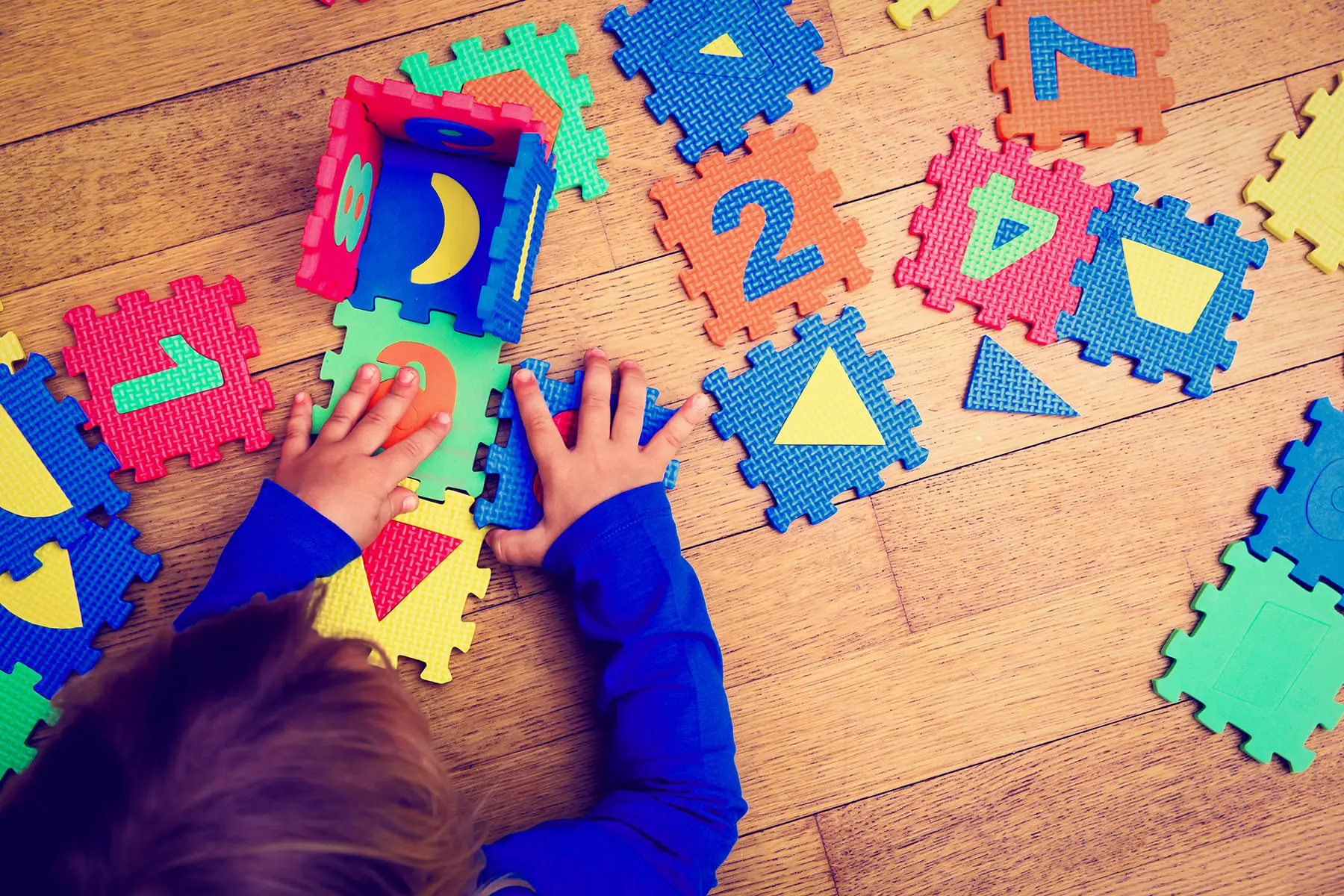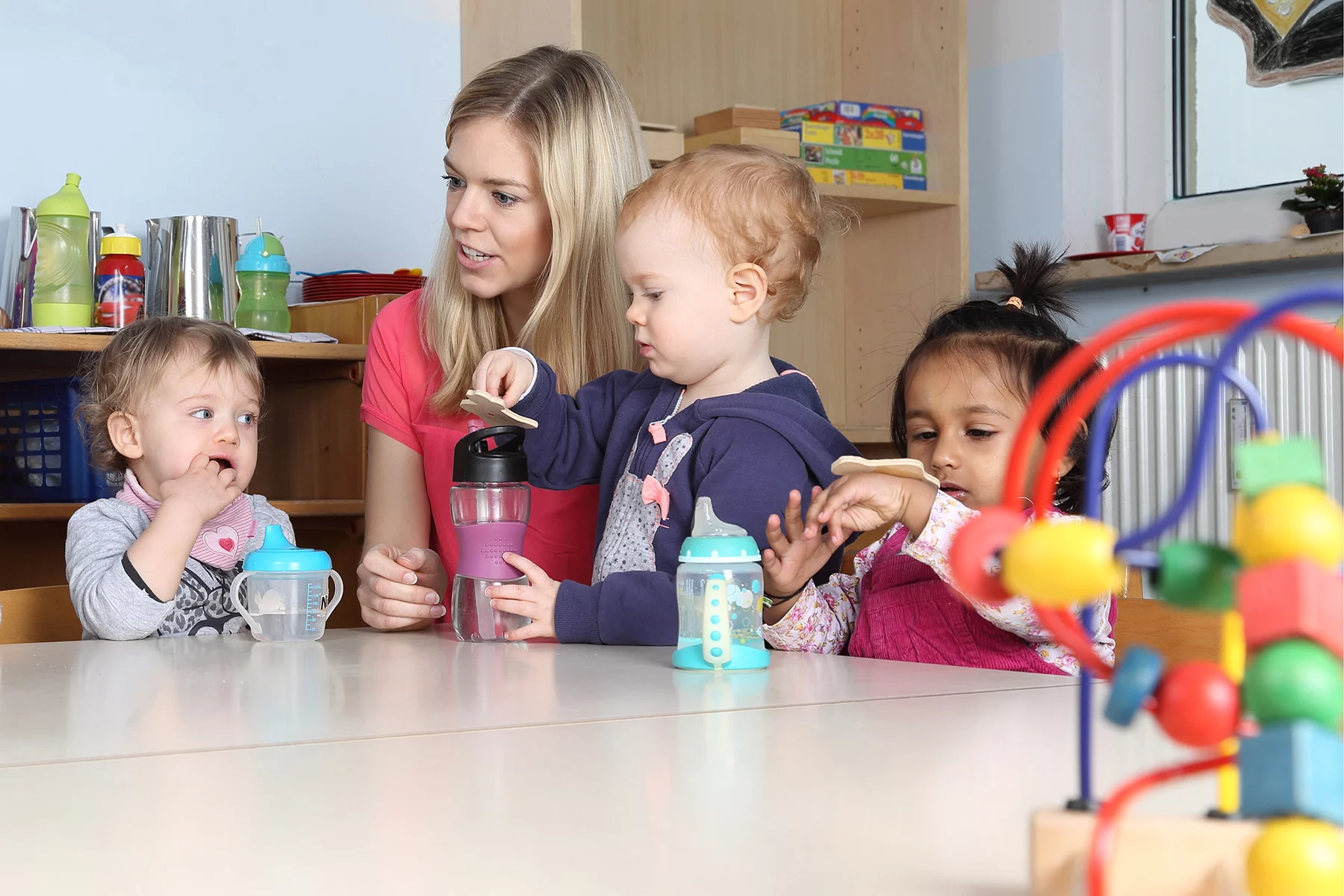In Germany, every child has a legal right to attend kindergarten between the ages of three and six. Compulsory education then begins at age six.
German daycare options range from structured kindergarten groups to smaller, privately run child-minding services. Some kindergartens also accept children under the age of three in toddler groups. These are run by local authorities, religious organizations (generally protestant or Catholic churches) or by private associations.
This guide – provided by International School on the Rhine – covers the following topics:
- Childcare in Germany
- Types of German daycare and preschools
- Kinderkrippe in Germany
- Kitas in Germany
- Kindergarten in Germany
- Schulhort in Germany
- International daycare and preschool in Germany
- Other childcare options in Germany
- Transition from German preschool to big school
- General tips for German preschools
- Useful resources
International School on the Rhine
The International School on the Rhine is located in the Düsseldorf – Neuss – Cologne region. It offers an excellent international education through full-day schooling in a multilingual environment. ISR offers an outstanding academic program, individual support for students, and several extra-curricular activities through a non-selective, college-preparatory education system.
Childcare in Germany
As of 2013, every child in Germany has the legal right to childcare. There are 790,000 children under the age of three attending a daycare facility.
As of August 2018, Berlin’s regional government began phasing out fees for municipal childcare centers; this includes fees for children under the age of one. However, parents with children aged one to six still have to pay for food in daycare centers.
Costs for childcare in other regions vary.
Equality in access to German daycare is a controversial topic in recent years. An OECD report found that only 13% of children under the age of three with an immigrant background attend daycare in western Germany.
It is compulsory for children in Germany to spend at least nine years in education. This starts at the age of six. Around 725,000 children started school in 2018/19.
You can find out more about the German school system in our guide to education in Germany.
Types of German daycare and preschools
There are several types of care available for children in Germany:
- Kinderkrippe (creche): designed for babies and children up to three-years-old. It is not free and costs may vary according to region.
- Kindergarten: for children between three and six-years-old. It is not a part of the regular public school system and is neither necessary nor free. Tuition is normally means-tested; those with lower incomes may pay less. Spaces are often in short supply even though it’s not mandatory. Still, the majority of three to six-year-olds attend them.
- Kitas (Kindertagesstätte, children’s daycare center): after-school and sometimes preschool activities for children. It’s for children up to age of 11 or 12-years-old. Fees apply, and they are a popular form of daycare in Germany.
- Schulhort: after-school daycare for primary school pupils.
Kinderkrippe in Germany
What is a kinderkrippe?
Kinderkrippe is a creche for very young children, usually between the ages of one to three.
Creches tend to be privately-run. Therefore, you’ll usually need to pay to use them. There may be a few services from local authorities and churches, depending on where you live.
The aim of kinderkrippe is to get your child used to socializing with other children from a young age.
As the children are so young, groups tend to be quite small to ensure each child is properly looked after.
The State Youth Welfare Office (Landesjugendämter) of the state supervises the provision of German preschool.
What do children do at kinderkrippe?
Creches encourage children to engage in supervised play. Socializing is the main aim here; children learn to get along with others and develop communication skills.
There will often be time playing outdoors, singing songs, reading picture books and perhaps learning to play simple musical instruments.

Staff may divide the group of children depending on their stages of development. For example, they may have groups for babies who are crawling and those who can walk.
Hours tend to be quite flexible. Many parents can fit the hours their child spends at a creche around their working day. A full day at the creche tends to last seven hours.
If you’re planning for your child to spend several hours at a creche, check to see any food is provided. Some may provide snacks, but many don’t.
Finding and choosing a kinderkrippe in Germany
For many years, the birth rate in Germany had fallen to a worryingly low level. The blame fell on the country’s lack of subsidized childcare services.
But now, a rule is in place that every child has a right to German preschool daycare from their first birthday. However, it can still be a struggle to find a place for your child.
Research into how young children fared when their parents were not from Germany concluded that migrant parents find it more difficult to find daycare for their children.
To look for local daycare services, check your area’s Youth Welfare Office (Jugendamt). Ask friends, neighbors, and colleagues for recommendations.
When choosing where to apply, consider the creche’s location, the child-to-minder ratio, whether any staff speaks English, what the opening hours are, whether food is available, and whether the facility has its own outdoor space.
How to enroll for kinderkrippe
Due to high demand, you may find that you’ll have to put your child’s name down for a creche months before they’ll be old enough to actually attend.
Many parents will sign up to several creches in case they can’t get in. In fact, it’s not unheard of for some parents to register their children for daycare before they’ve even been born.
You’ll need to make an appointment with the creche’s administrator to register yours and your child’s details.
You must provide documents to verify your identity and address. Take your passport or driving license, documentation showing your name and address. The baby’s birth certificate may also be necessary.
You should check what is necessary before you attend the appointment.
Costs of kinderkrippe in Germany
Costs for creche services can vary a lot – there isn’t really a typical price. It depends on the area and whether the creche is public or private.
In some cases, fees change depending on how much you earn. Some services provide means-tested discounts for parents on low wages.
Kitas in Germany
What is a kita?
The term ‘kita‘ is short for kindertagesstätte. It’s a German preschool daycare service for children between three and five/six. Depending on their birthday, children move onto full-time primary school education while they’re six-years-old.

Sessions are supervised by qualified Erzieher/innen (educators). There should be a relatively low ratio of children to educators. This ensures each child receives a high level of attention and care.
The State Youth Welfare Office (Landesjugendämter) of the state supervises the provision of German preschool childcare.
What do children do at a kita?
Kitas tend to have longer days than kindergarten. They’re generally open from around 7:00 to 17:00 or later. Parents can usually negotiate which hours they want their child to attend with the kita. Children receive seven to nine hours of free care in a kita.
Many kitas have an initial period called eingewöhnung. This is when children ease into spending time in daycare. This can mean just spending 15 minutes at a time apart from their parents at the start.
If your child will spend several hours at a kita, check whether food is provided or if you’ll need to give your child snacks to have throughout the day. Some places will provide food, others won’t.
Much like kinderkrippe, children engage in educational play, usually taking a step up with more advanced games. There’s also an introduction to learning about letters, numbers, values, good behavior, and movements through games or dance.
Staff don’t formally assess children on what they learn. However, staff do supervise them and track of their progress.
Finding and choosing kitas in Germany
Places in kitas are in high demand. Much like with kinderkrippe, parents register their children well before they are old enough to attend; many facilities have waiting lists.
It’s not unheard of to be placed 50th on a kita‘s waiting list. Places usually move quickly, however; children move onto primary school every year, after all.
There tend to be more bilingual services in large cities. This may not be the case in smaller towns or rural areas.
Your area’s Youth Welfare Office lists nearby kitas. kita.de (in German) also has a search function to help you find local services. It’s also worth asking friends and other people you know for recommendations.
Before signing up, consider whether the location works for you, the child-to-minder ratio, whether any staff speak English, what the opening hours are, whether food is available, and whether there’s any outdoor space.
How to enroll for a kita
It’s best to put your child’s name down for a kita as soon as possible. It’s likely there is a waiting list.
Once you’ve found a kita you want to apply for, you can tour the facility, register your details, and sign a contract to confirm a place.
You’ll need to provide ID, proof of address and your child’s birth certificate.
It’s usually at this point that staff take you through what happens if your child falls ill and when their holiday closures are.
Costs of kitas in Germany
The cost of kitas vary. In some states, you can apply for a Kita Gutschein – a kita voucher – which means you’ll get money off. How much you save depends on how much you earn; those with lower incomes will get more of a saving.
To apply, you’ll have to fill out a form (the Youth Welfare Office will have information on this).
You must provide ID, proof of address, proof of consent for you and your partner (if applicable), and your child’s birth certificate.
There may also be extra costs to pay for food and any trips the children are taken on.
Children can get more free hours at a kita if both parents work full-time.
Kindergarten in Germany
What is kindergarten?
An alternative to a kita, kindergarten is also for children between the ages of three and six.
These German preschools are usually run by churches, local authorities, specially-founded associations, and other private companies.

In a similar way to a kita, kindergartens aim to educate and socialize young children and prepare them for primary school.
Qualified Erzieher/innen (educators) supervise the sessions. Again, there should be a relatively low ratio of children to educators.
The State Youth Welfare Office (Landesjugendämter) supervises German preschool childcare.
What do children do at kindergarten?
Kindergarten hours usually see children arriving at 9am, and leaving at midday or mid-afternoon.
There is no formal education, but kids usually engage in activities such as educational play. There are more advanced games with an introduction to letters, numbers, values, and good behavior.
Children don’t receive formal assessments on what they learn. However, staff do track their progress.
Some kindergartens will provide children with food, but not all of them will. You may have to pay extra for food provisions, or you may have to provide a packed lunch and snacks.
Finding and choosing a kindergarten in Germany
As with krippes and kitas, it can be difficult to secure a place in a kindergarten that’s well-located and good value.
Services vary depending on where you are. Generally, bilingual kindergartens are particularly difficult to find space in. However, even if you don’t manage it, there is usually at least one staff member that speaks English.
Before signing up, consider whether the kindergarten’s location is convenient for you, the child-to-minder ratio, whether any staff speaks English, what the opening hours are, whether food is provided, and whether there’s any outdoor space.
How to enroll for kindergarten
Long waiting lists are common when signing your child up to a kindergarten. Most people register several months in advance.
There’s not usually an interview process, but many kindergartens allow you to visit before registering your details.
You’ll need to provide ID, proof of address, proof of consent for you and your partner (if applicable), and your child’s birth certificate.
Costs of kindergarten in Germany
Prices vary widely. Some kindergartens are totally free, while some cost hundreds of euros each year.
How much you pay depends on what area you live in, what facilities are available, and, often, how much you earn. Those on lower incomes can often pay reduced fees, however.
Schulhort in Germany
What is schulhort?
For older children over the age of six who are in primary school, schulhort services provide extra after-school daycare.
This can fill in the gap between school finishing and parents being able to pick their children up after work. Depending on what’s available, this gives children the opportunity to try new sports and activities that aren’t available during school hours.

The services are usually provided by the individual school. What’s on offer depends on what facilities are available and what the demand is like.
In some cases, the after-school care may be provided by teachers. Sometimes staff from an external organization come in to take the sessions.
What do children do at schulhort?
Elementary school hours in Germany generally run from 8:00 to 13:00 or 14:00. After this time, many schools provide a teacher’s assistant to look after children until 16:00. This service and the hours vary between schools, however.
Activities vary, but often include playing board games, learning crafts, playing instruments, learning karate, or playing football.
Depending on the activities taking place, children may be split according to age and ability.
Meals aren’t usually provided, but some schulhort services may provide snacks. You should always check this beforehand to make sure your child doesn’t go hungry!
As after school sessions are voluntary, they’re not usually assessed. However, for activities like karate and learning musical instruments, there may be different levels and grades children can progress with.
Finding and choosing a schulhort in Germany
As schulhort services are tied to the school your child attends, there’s not usually a process of searching and applying for one.
While this could mean the process is fairly easy, if your child’s school doesn’t have the means to cope with the demand, it could put parents in a tricky situation. As a result, they’ll have to consider alternatives such as a childminder.
Consider how much schulhort activities cost, how long your child is looked after, whether any food is provided, how many other children go along, and what your child does when they attend.
How to enroll for schulhort
As schulhort services are offered by your child’s school, you should register your interest with the school itself.
Availability will depend on whether the activities are over-subscribed – if they are, there may be a waiting list.
Places will generally be open for all children.
Costs of schulhort in Germany
Fees for schulhort vary depending on the service being offered, what facilities are required, how long the child is looked after for, and whether any meals are included.
Some schools may offer reduced fees for parents with lower incomes, but, again, this will vary depending on the school.
International daycare and preschool in Germany
Advantages of using international daycare
While international daycare can be a bit more difficult to find, there are several potential benefits.
As the world is becoming increasingly global, it’s a good idea to expose children to people from different cultures as early as possible.
Numerous studies find that bilingual children often outperform those who only speak one language. This includes when it comes to maintaining concentration and multitasking.
What do children do at international daycare?
Children usually do similar activities at an international daycare as at a normal daycare. There’s usually an added focus on learning about other cultures, religions, and languages.
Younger children generally learn about letters, numbers, values, and good behavior.
Finding and choosing international daycare in Germany
There’s a lot of competition for all kinds of daycare services in Germany. As international daycares are rarer, it can be even more difficult to get a space. Parents often put their children’s names on waiting lists for many months, or even years.
If you plan on enrolling your child in an international school, they probably have an international kindergarten for the younger ones, such as International School on the Rhine where children are taught in English but also have German classes.
Your local Youth Welfare Office can let you know what daycare options are available in your area.
How to enroll for international daycare
As with other types of daycare, you’ll need to contact the service and register yours and your child’s details.
If the service is over-subscribed, your child may be put on a waiting list. As a result, your child won’t be able to attend until space becomes available.
Costs of international daycare in Germany
Fees vary widely depending on where you are, and whether there’s a high demand for international daycare services.
Parents on lower wages may be able to pay lower fees. However, this is often at the discretion of the daycare service.
Once your child is older, you might be interested to read our guide to international schools in Germany.
Other childcare options in Germany
Au pairs and nannies
Nannies and au pairs provide childcare in your own home. They either visit your home or live in your home.
They must be approved by the youth welfare office. Formal childcare qualifications are not necessary for au pairs and nannies.

A nanny or au pair generally only looks after your children. As a result, their services can be more expensive.
Home daycare (Kindertagespflege)
These kinds of childcare providers, also known as childminders, look after children in their own homes. Generally, they’ll look after three or four children at a time.
They do not need certification, as staff are who work in kitas and kindergartens. However, the youth welfare office must approve them.
Our guide can tell you more about finding childcare in Germany.
Transition from German preschool to big school
German daycares and preschools get children used to socializing with children their own age, being away from their parents, as well as becoming familiar with the system of being in a class.
Some German preschools even hold lessons in primary schools. This is so children become familiar with the specific rooms they’ll use after moving to a school.
The educational and developmental aspect of daycare also gives children a head start. They’ll have already started some of the topics covered in primary school.
General tips for German preschools
- Label all clothing and bags with your child’s name.
- Take fruit and snacks along; some daycare providers will give children food, but some don’t.
- Take along a pair of soft indoor shoes for your child.
- Come prepared with emergency and doctor contact information.
Useful resources
- Federal Agency for work – family and children (link in German)
- deutschland.de – information and background on Germany’s education system
- Studying in Germany – find out more about education in Germany




